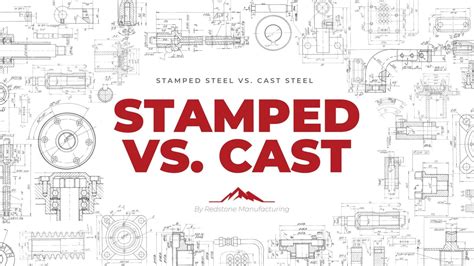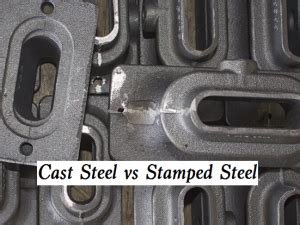cast iron vs stamped steel box In general, cast steel is used for applications that require higher strength and durability, while stamped steel is used for applications that require a more cost-effective solution and are not as demanding in terms of strength . Gratury Junction Box, IP67 Waterproof Plastic Enclosure for Electrical Project, Hinged Grey Cover, Includes Mounting Plate and Wall Bracket 290×190×140mm (11.4"×7.5"×5.5")Find Weatherproof electrical boxes at Lowe's today. Shop electrical boxes and a variety of electrical products online at Lowes.com.
0 · stamping steel vs cast steel
1 · stamped vs cast steel
2 · is stamped steel rust resistant
3 · does stamped steel rust
Meet your installation needs with weatherproof security camera mounting junction boxes. Junction Boxes allow you to conveniently hide your security camera cables from view and protect them from vandalism while also providing easier access to cabling connections without having to unmount your camera.
You cant get a tight seam between the cast iron top and the steel wings. At least, you cant on the SawStop. The steel is harder to keep clean and the uneven surface can be .Let's explore the key differences between cast iron and steel: 1. Carbon Content. The carbon content is the primary distinguishing factor between cast iron and steel. Cast iron contains 2 .What is the difference between cast iron and steel? Cast iron has a higher carbon content, making it more brittle but excellent for heat retention, while steel is stronger, more ductile, and versatile.An infographic showing the differences between cast iron and stamped steel.
In general, cast steel is used for applications that require higher strength and durability, while stamped steel is used for applications that require a more cost-effective solution and are not as demanding in terms of strength .Cast iron is relatively easy to cast, as it pours easily and doesn't shrink as much as steel. This flowability makes cast iron an ideal metal for architectural or ornate ironwork structures such as fencing and street furniture. Cast Iron Vs Steel: Which One to Choose? Choosing between these metals will require knowing the pros and cons of both metals. Below are their advantages and disadvantages. Cast iron is durable but brittle, easily cracking or breaking under stress. It works best for applications that require compression strength, such as engine blocks and pipes. On the other hand, steel is much stronger and .

Cast Irons: There are 4 types of cast iron: White Cast iron, Grey Cast Iron, Malleable Iron and Ductile Iron. All cast irons have much higher carbon than steels, usually . Choosing stamped steel vs. cast steel can be a difficult decision. Overall, it perfectly combines strength and ductility, which makes it the perfect metal choice across countless industries. The process is ultimately up to two primary factors: part application and budget. You cant get a tight seam between the cast iron top and the steel wings. At least, you cant on the SawStop. The steel is harder to keep clean and the uneven surface can be problematic when trying to align things. HIGHLY recommend the cast iron if .Let's explore the key differences between cast iron and steel: 1. Carbon Content. The carbon content is the primary distinguishing factor between cast iron and steel. Cast iron contains 2-4% carbon, which gives it unique properties like high compressive strength and excellent castability.
What is the difference between cast iron and steel? Cast iron has a higher carbon content, making it more brittle but excellent for heat retention, while steel is stronger, more ductile, and versatile.An infographic showing the differences between cast iron and stamped steel.
In general, cast steel is used for applications that require higher strength and durability, while stamped steel is used for applications that require a more cost-effective solution and are not as demanding in terms of strength and durability.Cast iron is relatively easy to cast, as it pours easily and doesn't shrink as much as steel. This flowability makes cast iron an ideal metal for architectural or ornate ironwork structures such as fencing and street furniture. Cast Iron Vs Steel: Which One to Choose? Choosing between these metals will require knowing the pros and cons of both metals. Below are their advantages and disadvantages. Cast iron is durable but brittle, easily cracking or breaking under stress. It works best for applications that require compression strength, such as engine blocks and pipes. On the other hand, steel is much stronger and tougher due to its carbon composition.
Cast Irons: There are 4 types of cast iron: White Cast iron, Grey Cast Iron, Malleable Iron and Ductile Iron. All cast irons have much higher carbon than steels, usually well in excess of 2%, often approaching 3-4%. Choosing stamped steel vs. cast steel can be a difficult decision. Overall, it perfectly combines strength and ductility, which makes it the perfect metal choice across countless industries. The process is ultimately up to two primary factors: part application and budget. You cant get a tight seam between the cast iron top and the steel wings. At least, you cant on the SawStop. The steel is harder to keep clean and the uneven surface can be problematic when trying to align things. HIGHLY recommend the cast iron if .
Let's explore the key differences between cast iron and steel: 1. Carbon Content. The carbon content is the primary distinguishing factor between cast iron and steel. Cast iron contains 2-4% carbon, which gives it unique properties like high compressive strength and excellent castability.What is the difference between cast iron and steel? Cast iron has a higher carbon content, making it more brittle but excellent for heat retention, while steel is stronger, more ductile, and versatile.An infographic showing the differences between cast iron and stamped steel.
In general, cast steel is used for applications that require higher strength and durability, while stamped steel is used for applications that require a more cost-effective solution and are not as demanding in terms of strength and durability.Cast iron is relatively easy to cast, as it pours easily and doesn't shrink as much as steel. This flowability makes cast iron an ideal metal for architectural or ornate ironwork structures such as fencing and street furniture. Cast Iron Vs Steel: Which One to Choose? Choosing between these metals will require knowing the pros and cons of both metals. Below are their advantages and disadvantages. Cast iron is durable but brittle, easily cracking or breaking under stress. It works best for applications that require compression strength, such as engine blocks and pipes. On the other hand, steel is much stronger and tougher due to its carbon composition.
highline junction box
stamping steel vs cast steel
stamped vs cast steel
is stamped steel rust resistant

How I installed a weatherproof outdoor electrical outlet box on vinyl siding using sheet metal screws and caulk. - Updated June 7, 2024
cast iron vs stamped steel box|stamped vs cast steel